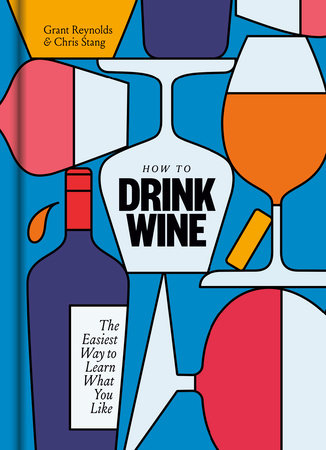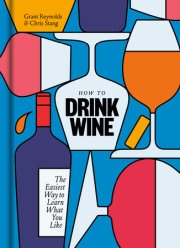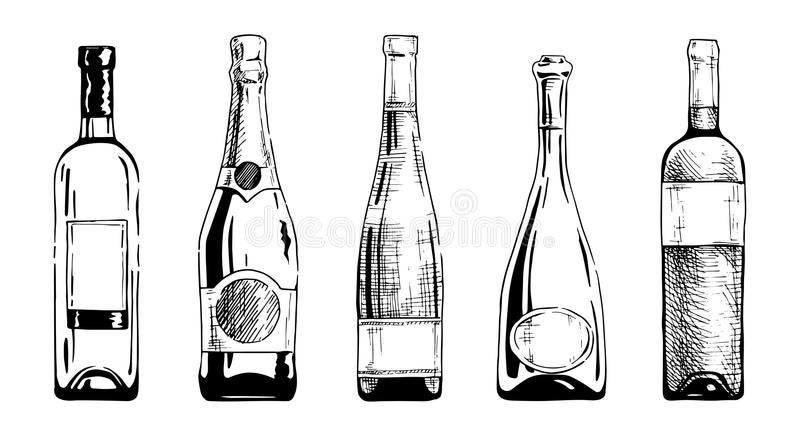Introduction Ninety-eight points. A stunning expression of terroir.Notes of saddle and wet river rock.Appellation. Mouthfeel. Some French words. Did your eyes glaze over yet? Have you given up and reached for a beer? We don’t blame you. The world of wine can be a complex, intimidating thing. But wine can also be a lifelong pursuit—one that creates limitless opportunities to try new things, meet new people, see new places, and share new experiences. What other kind of drinking can offer you all of that?
We, your grateful authors and semiprofessional wine drinkers, formed a friendship in exactly that way—over shared experiences around wine. We became obsessed with the idea that learning about wine can (and should) be easier and more relatable. And then we decided to write this book.
Grant owns a wine retail shop called Parcelle. He is also the wine director and a partner in Delicious Hospitality Group, which runs several restaurants in New York City that, in addition to serving excellent food, are all centered around the idea that one can be very serious about wine, but not
too serious. The restaurants are havens of hospitality where someone who collects Burgundy can sit down and drink things that can’t be found on any other list in town—but they’re also places where someone who knows nothing about wine will be treated well while also being convinced to try a coastal Italian white instead of their usual glass of Sancerre. The entire experience is delivered with a focus on discovery and not even the slightest hint of condescension. And that’s why his restaurants have been so successful. Grant is also one of the youngest people ever to pass the Advanced Sommelier course and was a Forbes 30 Under 30 honoree, but we don’t boast about accomplishments and awards like that around here.
Chris was nominated for a James Beard Award for Humor Journalism in 2015 and was deemed “arguably the most influential restaurant reviewer in America” by the
Financial Times in 2019. He is the cofounder and CEO of The Infatuation, a global restaurant review platform that found success by making restaurant discovery more relatable. Think about it this way: When was the last time you and some friends sat down and chose a restaurant by saying, “Who is the best chef in town? Let’s eat there.” It’s more likely that you discussed things like location, atmosphere, and experience, and then tried to find the best restaurant that fit into those parameters. That’s what The Infatuation’s restaurant reviews and guides do for you—all with a sense of levity and irreverence to keep things grounded. And that’s what Chris will do here with wine.
So, the question is, how exactly can the world of wine become more relatable? We’re clearly not the first people to write a book like this one. But we might be the first people who don’t expect you to memorize sixty-three grape varietals and tasting notes for each one. If that’s something that interests you, break out the flash cards. But there’s an easier way to acquire the knowledge you need in order to start exploring, and it all starts with one word: “Why?”
Instead of spending a bunch of time with a textbook and a highlighter, you should start by pouring yourself a glass of something you like and thinking about why you like it as you drink. A few things will probably come to mind. But you also might find yourself struggling to find the right words to describe those things. That’s the first place people get hung up—and that brings us to our mission here.
This book will enable you to learn how to drink wine by helping you understand why you like what you like—and then it will take you down a path of discovering other wines that share those characteristics that please you. Giving you some words to work with is the first step; but we’ll also help you by explaining why some things are the way they are, and why there are a whole bunch of things you don’t need to concern yourself with—yet. Wine is a journey. Everyone has to start somewhere. This book is the easiest first step you’ll ever take.
The Words You NeedThis glossary is not comprehensive—we’re not going to teach you every word used in the world of wine. We will, however, help you become familiar with the way people talk about wine. This overview of basic terminology will allow you to begin to build a vocabulary to describe the things you like, and help you understand how to communicate the things you don’t. Think of it this way: We aren’t trying to make you fluent, but we will give you the equivalent of knowing how to say “Where is the bathroom?” or “This dog is my friend” in the language of wine. And right now, that’s all you need.
Alcohol by Volume: You may see the letters “ABV” or “alc.” on a wine label followed by a percentage, which is usually between 11% and 15%. This represents a wine’s alcohol by volume. Besides the fact that 15% will get you 4% drunker than 11%, it’s useful to know that the higher the alcohol percentage, the bigger (see “Big,” next column) the wine will taste. Lower alcohol wines will be crisper, lighter, and easier on your head in the morning.
Acidity: You’ve tasted citrus before; you know what acid is. In wine, this word is important for describing what you taste (a strong presence of acid or the lack thereof is an important part of the flavor of any wine), but acid also affects how long a bottle can age. Wines with higher acid, like pinot noir or Riesling, will generally last longer in a cellar.
Age or Aging: A bottle of wine isn’t like a jug of milk—it won’t turn into cheese if it sits around for a few months or years. It will, however, change over time as it sits in the unopened bottle. This is called aging. Wines are aged to alter their flavor, and to make them more enjoyable to drink. Depending on many factors, some wines take on age better than others. You may hear those referred to as “age-worthy.” Bordeaux wines are classically “age-worthy.” So is Harrison Ford.
Big: Most often used to describe a style of red wine. “Big” wines are bold, heavy, high in alcohol, juicy, and sometimes sweet. Cabernet sauvignon and shiraz are great examples of big wines.
Blend: A blend is when two or more grapes have been combined to make one wine. How and when the grapes are blended together can vary depending on the winemaker’s process. Blended wines are usually big, fruity, and made from predominantly cabernet or merlot.
Body: How a wine feels in your mouth. Think of it like someone sitting on your lap. Is that a light-bodied friend or a full-bodied friend? Instead of referring to weight, body refers to a richness of flavor when you’re talking about wine. The spectrum of body that we’ll refer to in this book will be light, medium, full. Light-bodied wines have avors that are subtler, crisper, and more refreshing than those of bigger, full-bodied wines. A pale color can help indicate a light wine, as can an alcohol percentage below 13.5%. Medium-bodied wines are middle of the road in flavor and richness. They aren’t too light and nor are they too big and powerful. Full-bodied wines are high in tannin, alcohol, and flavor. They are often darker in color than light- and medium-bodied wines. An alcohol level above 15% is a safe indicator, too.
Corked: A certain bacterium can live on corks that will make the wine taste like dirty socks. In fact, this dirty-sock flavor is often what a server or sommelier is having you taste for when he or she pours you that first tiny sip of the bottle of wine you ordered. Contrary to popular belief (and sometimes usage), “corked” does not refer to pieces of cork getting into a bottle. It refers to socks getting into a bottle.
Creamy: The texture of some white wines. A creamy wine feels rich, soft, and heavy in your mouth—like drinking cream—rather than tart like a lemon. Creamy white wines also tend to be full bodied. Chardonnay is a great example.
Crémant: The term for any sparkling wine from France that isn’t made in the Champagne region (see page 46 for more on the “Champagne region”).
Crisp: Another word to describe texture in white wine. It is typically synonymous with a wine being “thirst quenching” and is the opposite of creamy—like an ice-cold glass of lemonade. Crisp white wines tend to be light bodied.
Cru: A very nice, very French way of saying vineyard.
Cuvée: A term used to differentiate wines made by the same producer. A cuvée is often from a specific vineyard or a special blend of grapes. Think of it as you would any company that classifies products that are similar but might have variations in quality or specifications—like the way Mercedes classifies its cars (SL 500 or CLS 450) or Nike classifies its shoes (Air Max, Air Force 1).
Decant: The process of pouring wine from its bottle into another vessel, typically a glass vase-like receptacle called . . . a decanter. The purpose of taking this action is typically to separate old wines from sediment (see page 16), or to soften younger wines so that they become more palatable.
Copyright © 2020 by Grant Reynolds and Chris Stang. All rights reserved. No part of this excerpt may be reproduced or reprinted without permission in writing from the publisher.



